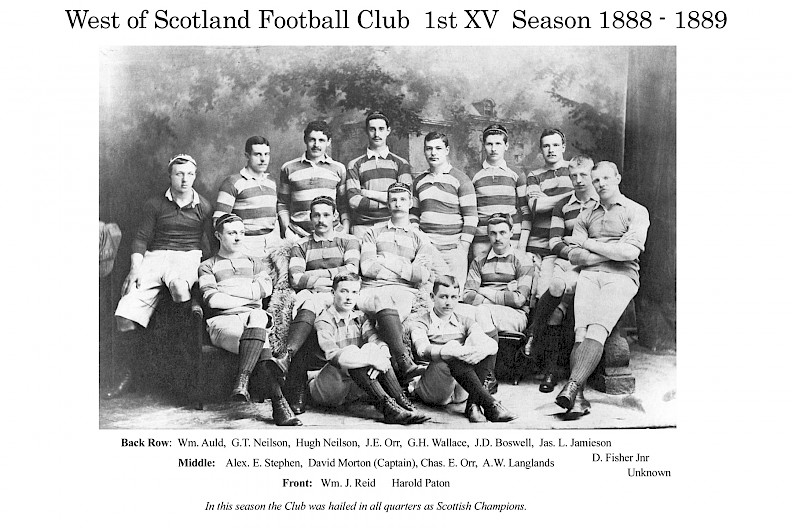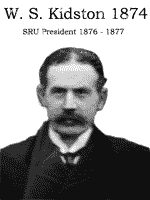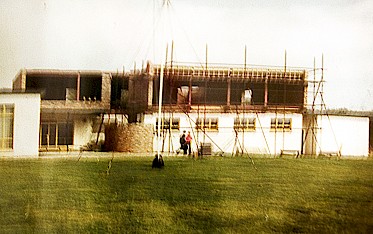
About West
The first 100 Years (extract from West of Scotland Football Club 1865/1965 – C. D. Stuart)
Tracing the early days of the West of Scotland Football club is difficult. Records are few and those who could have given valuable information are long since gone. But scant notes extant all place the date of the Club’s inauguration as 1865. The club originated and settled at Hamilton Crescent in Partick, Glasgow as an off-shoot of the Cricket Club which was formed in 1862, the bye laws of West of Scotland Football Club being agreed at a meeting on the 15th October 1865.

At that time play was confined to contests between club members with twenty men per side being the order of the day. This changed, however, when the first meeting with Edinburgh Academicals was arranged at Hamilton Crescent for 15th November 1867, the second at Raeburn Place on 14th December of the same year (West won the first and the Accies the second).
In those days the Laws differed enormously from today. Goals alone counted and tries, as the name implies, only gave the side which touched down a chance to kick at goal. The term ‘try’ was not used; it was a ‘run in’ or a ‘touch down’. Whoever touched the ball when it crossed the side line threw it in. The in-goal area was unrestricted, the ball not dead until a hand was placed upon it. Glasgow Accies record that when once playing West the ball hit a fence and went into an adjoining field. Quick thinking by J W Arthur who leapt over the barrier – got the touch, and thus saved a try. In these matches there were seventeen forwards. The ball too was quite a different shape, resembling the one used by the Associationists – this was occasioned by the fact that the rubber bladder and inflator had not yet appeared and a pig’s bladder encased in four panel cowhide was employed.
At the AGM of 1871 a new uniform (‘strip’) was approved. Originally the club colours had been blue. Now it was changed to yellow and red striped jerseys, knickerbockers or trousers of white and red and yellow striped stockings. At this time there was no President, the Club Captain being the official representative. It was not until 1890 that the office of President was established and W. H. Kidston was elected, becoming the first in a long line of outstanding Presidents of the West of Scotland Football club many of whom went on to become Presidents of the SRU.

At this juncture (1871) England had outstepped Scotland and had formed the Rugby Union. It did great service by drafting laws on the Rugby School pattern. This gave a measure of uniformity that had been lacking. It is notable that West of Scotland FC were the first Scottish club to join this English Union. A year later the first steps were taken in the formation of the Scottish Rugby Union at a meeting at Elmbank academy and the first members were Edinburgh Academicals FC, West of Scotland FC, Royal High School FP, Glasgow Academicals, Merchistonians and Edinburgh University.
Between 1881 and 1885 West won the club championship twice and provided a number of player including captains to the National side. By this time the game was becoming more regulated with the appointment of two umpires (who carried a stick) and a referee (who had a whistle) – innovation indeed! Changes in the scoring also came about over the next few years with the formation of an International Board formed by Scotland, Ireland and Wales ( England at first refused to join). This is when a touch-down (try) started counting as a score.
In the early 1890’s the West teams were strong and they won or shared the Championship a number of times. Difficulties (mainly financial) with the Cricket Club, who owned the ground, started to arise. The Cricket section was always short of money and were making greater demands on the Football section. However, just after the turn of the century, the Cricket sections finances improved and West’s lease was extended for a further ten years at an annual rental of £70. It should be noted that many players were members of both sections.
The first world war (1914 -18) not only saw no play for 5 years but also a decimation of many fine players. A number of local clubs did not survive the loss of so many players and West gained a number of surviving fine players from clubs like Clydesdale and Partickhill. In the early 1920’s an attempt was made to amalgamate the Cricket and Rugby Football Clubs but this failed as the Cricket club failed to achieve enough votes in favour. The Rugby Club therefore continued to rent the ground (about £100 pa) although the pitches were once referred to as ‘seas of mud’ and the one shower and cold bath did little to encourage training. As a Club, however, West continued to thrive, often fielding 4 XV’s and attracting many fine player, a number of whom went on to gain District and International honours.
The latter part of the 1920’s and the start of the 1930’s saw the loss of one Club stalwart and the introduction of a number of others. In 1929 one of Scotland’s great Rugby personalities, W. H. Kidston died. He was responsible, with others for introducing the kicking code to Scotland In his early days had played for West and Scotland, was Honorary Secretary for 18 years and the first President of West of Scotland FC. He was also to the fore when the SRU was formed and later became President of that organisation. These years also saw people like Bill Nicholson, W. A. Burnet, H. Stewart Mackintosh (later Director of Education for Glasgow) and Arthur Ferns becoming involved both in playing terms and later in the transfer of West to Burnbrae. Although the Club had limited success on the playing field at this time it had a large membership. At Partick all available ground was in use and a lease was arranged for Renfrew Cricket Clubs ground to help relieve the situation and, through the courtesy of Glasgow High School FP training facilities were made available at Old Anniesland.
The late 1930’s and early 1940’s saw the commencement of hostilities of the 2nd world war and accounts were settled and arrangements cancelled with the Cricket Club at Hamilton Crescent. It was something of a bombshell that, when hostilities were over, a letter was received from the Board of the Cricket Club saying that they did not see their way to permit the Football Club to return to Hamilton Crescent. The die was cast and the first 80 years of the Club’s history ended with them ‘out on the ear’ and nowhere to go. West had many friends, however, in Rugby circles and it was not long before an agreement was reached with Kelvinside Academy to run a joint side and play at Balgray. This was to continue until 1951 when the numbers of Kelvinside’s own players made it unpractical for West to continue with the arrangement. During this time tremendous efforts were made by club officials A. D. Ferns, M. D. Ballantyne, H. S Mackintosh, W Nicholson, J.A.D. Thom, W.A. Burnet and President Hugh Harper to find a new home for West. Grounds at Whitecraigs, Pollock Estate, Stepps, Kirkintilloch/Bishopbriggs were considered but all had to be discarded for one reason or another. The result was that in 1951 West were fielding six XV’s but had no home. What they did have was a determination to continue, growing Club funds, and many friends willing to help. They played their games at Glasgow Accies, St Aloysius, Balgray, Glasgow University and Old Anniesland and continued to thrive.
At last, in 1952, a site was identified on the Mains Estate in Milngavie which was certainly of sufficient size. In the words of Bill Nicholson “Eventually, after negotiations had been going on from the end of 1952, in July 1953, we bought (for £1000) a marshy site at Burnbrae, with a certain amount of optimism, quite a lot of courage and not a little faith”. It was not, however, until 17th September 1960 and a further expenditure of some £10000 that the first game (against Glasgow High School FP) was played at Burnbrae. The Club had survived for 15 years without a home.

The new home at Burnbrae also saw a revival of the playing sides with much more success on the field. Players like David Shedden, Sandy Carmichael, Tom Bottomley, Peter Brown and Quinton Dunlop and many others saw the 1st XV eventually becoming joint champions with Hawick in 1965.
It is notable that at the Centenary Dinner held in the Central Hotel, Glasgow the guests included the immediate past Prime Minister (Sir Alec Douglas Home), all four Presidents of the home Rugby Unions, Lord Fraser of Allander and innumerable internationalists and well known personalities. This showed the influence that West of Scotland FC had on the birth and development of rugby in Scotland.
The New Ground (Burnbrae) 1960 to present
Now that West had their own ground and clubhouse, which was opened by Lady Fraser on 22nd October 1960, the club was able to attract players of quality unable to join any of the local F.P. sides who retained their ‘closed shop’ policy.
West was thus the only senior open club in Glasgow at that time and any distinguished players moving into the area joined West. This led to a memorable era for the Club and in 1964 P.C. Brown became the first West player to be capped since before the second world war. Sandy Carmichael followed in 1967 and Gordon Brown in 1969.
Over the next few years a succession of players were capped for Scotland and indeed for England when Lionel Weston played for them at scrum half.
Two further pitches were constructed and lights provided on what became the training pitch. A wooden stand was kindly donated by members.
The club at this time ran a 1st XV, a 2nd XV, a 2A’s XV, a 4th XV and an under 18 ‘colts’ team. Membership of the club was eagerly sought and there was even at one time a waiting list for non-players. Pressure on space in the Clubhouse led to an upstairs extension being added with a Bar and Restaurant in 1973.

West were led by a succession of outstanding Club Captains in this period including Tom Bottomly, Alisdair Burnett, Tom Young, Quinton Dunlop, Sandy Carmichael, Brian Gossman and Colin Mair.
As the former pupils clubs found it necessary to become ‘open’ the outstanding players were then spread out over the Glasgow Clubs and West declined somewhat as a force. When the official SRU leagues were established however West were in Division 1.
The 1980's saw the development of first a 'midi' youth section and later a 'mini' section at West. This has since developed apace and now provides many of the players in the senior section.
The onset of professionalism in 1996 struck hard at West when seven of their best players either turned ‘pro’ or left to join other clubs where opportunities to go professional were more obvious. The most outstanding player in this group was Gordon Bulloch who went on to captain Scotland and play for the British Lions. It is significant that Gordon has now rejoined West.
It was at this period that the old wooden stand was lost to fire and a new 500 seater stand with dressing rooms and ancillary facilities was built.
The onset of professional rugby also led to a decline in support for Club rugby and subsequent financial pressures.
On the playing side the loss of key players in the late 1990’s saw West struggling to maintain its position in the top leagues, gradually sliding down to Premier 3 where its remained for a number of years.
In December 2002 after extensive negotiations with various parties Heads of Agreement were drafted between the Club and Cala Homes Ltd. which provided for that company to acquire the ground at Burnbrae for development purposes with West to move to new grounds within the area. This process continued for some seven years with various planning constraints and was finally agreed after a planning appeal. However the fall in house prices in 2008 and other financial constraints saw Cala finally pull out from the deal. Fortunately West had meanwhile agreed another plan with Town Centre Securities to build a Waitrose store on what was the roadside pitch with West gaining a synthetic all-weather pitch on the scrubland area to the east of the Scottish Water wayleave. Heads of Terms were agreed in 2009 and the planning process began again.
Meanwhile, on the playing side, with the appointment of John Beattie as head coach in 2005 and an influx of some new players the fortunes of the playing side began to improve. In 2006 the 1st XV won the BT Shield at Murrayfield and the following year saw a unique occasion when all three senior teams were champions of their respective leagues. The 1st XV again gained promotion the following year, this time to the then Premier 1 – where they remained for three years.
Further financial pressures in 2010 resulted in the 1st XV dropping out of the Premier 1 league with a subsequent loss of some key players. With league restructuring they ended up in what was then called Championship A – later to become National 3. In 2016 they finally managed promotion to National 2.
In 2014 the new Waitrose store was finally completed as was the new synthetic all-weather pitch. Final legal documents completing the deal were signed on the 31st July 2014. Five years of hard negotiation had given the club a new lease of life and a more secure financial footing.
The document below gives a content list of the material held in the East Dunbartonshire archives. Note that EDC will have to be contacted to view any ot the content items
 PDF Archive contents
PDF Archive contents